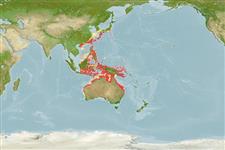Environment: milieu / climate zone / depth range / distribution range
Sinh thái học
Biển Cùng sống ở rạn san hô; Mức độ sâu ? - 50 m (Ref. 5222). Tropical; 35°N - 32°S, 110°E - 156°E (Ref. 5222)
Western Pacific: Japan to Australia. Unknown from the Indian Ocean except for the Andaman Islands record (as Serranus merra). Unreported from islands of Micronesia, Melanesia and central Pacific. Often misidentified as Epinephelus macrospilos or Epinephelus hexagonatus.
Length at first maturity / Bộ gần gũi / Khối lượng (Trọng lượng) / Age
Maturity: Lm ?, range 18 - ? cm
Max length : 40.0 cm TL con đực/không giới tính; (Ref. 48635)
Các tia vây lưng cứng (tổng cộng): 11; Các vây lưng mềm (tổng cộng): 16-18; Tia cứng vây hậu môn 3; Tia mềm vây hậu môn: 8. Distinguished by the following characteristics: whitish color; head, body and fins with numerous large close-set hexagonal to roundish dark brown to blackish spots; ctenoid body scales except cycloid dorsoanteriorly above lateral line, on thorax and abdomen; body with auxiliary scales; greatest depth of body 2.7-3.2 in SL; rounded caudal fin; pelvic fins, 1.7-2.1 in head length (Ref. 90102); head length 2.3-2.6 times in SL; evenly curved dorsal head profile; snout subequal to eye diameter, snout length 4.6-5.3 times in HL; rounded preopercle or subangular; upper edge of operculum almost straight; posterior nostril diameter about twice that of anterior nostrils; maxilla reaches to or past vertical at rear edge of eye; 2-3 rows of teeth on midlateral part of lower jaw; lower jaw barely projecting in front of upper jaw (Ref. 89707).
Inhabits inshore silty reefs; there are no records from depths greater than 50 m. Feeds on shrimps, small fishes, worms and crabs (Ref. 89707). The enlarged fleshy pectoral fins appear to have resulted from its habit of sitting on the substrate. Solitary (Ref 90102).
Heemstra, P.C. and J.E. Randall, 1993. FAO Species Catalogue. Vol. 16. Groupers of the world (family Serranidae, subfamily Epinephelinae). An annotated and illustrated catalogue of the grouper, rockcod, hind, coral grouper and lyretail species known to date. Rome: FAO. FAO Fish. Synop. 125(16):382 p. (Ref. 5222)
IUCN Red List Status (Ref. 130435)
Threat to humans
Reports of ciguatera poisoning (Ref. 30298)
Human uses
Các nghề cá: Tính thương mại
Thêm thông tin
Các tài liệu tham khảoNuôi trồng thủy sảnTổng quan nuôi trồng thủy sảnCác giốngDi truyềnElectrophoresesDi sảnCác bệnhChế biếnNutrientsMass conversion
Các công cụ
Special reports
Download XML
Các nguồn internet
Estimates based on models
Preferred temperature (Ref.
123201): 24.5 - 28.9, mean 27.7 °C (based on 504 cells).
Phylogenetic diversity index (Ref.
82804): PD
50 = 0.5000 [Uniqueness, from 0.5 = low to 2.0 = high].
Bayesian length-weight: a=0.01349 (0.00851 - 0.02138), b=3.05 (2.92 - 3.18), in cm total length, based on LWR estimates for this species & Genus-body shape (Ref.
93245).
Mức dinh dưỡng (Ref.
69278): 4.0 ±0.5 se; based on diet studies.
Thích nghi nhanh (Ref.
120179): Trung bình, thời gian nhân đôi của chủng quần tối thiểu là 1.4 - 4.4 năm (Preliminary K or Fecundity.).
Fishing Vulnerability (Ref.
59153): Low to moderate vulnerability (30 of 100).
Nutrients (Ref.
124155): Calcium = 34 [16, 71] mg/100g; Iron = 0.584 [0.306, 1.188] mg/100g; Protein = 18.4 [16.8, 19.8] %; Omega3 = 0.125 [0.078, 0.197] g/100g; Selenium = 30.1 [16.9, 58.5] μg/100g; VitaminA = 329 [88, 1,239] μg/100g; Zinc = 1.27 [0.85, 1.83] mg/100g (wet weight);
